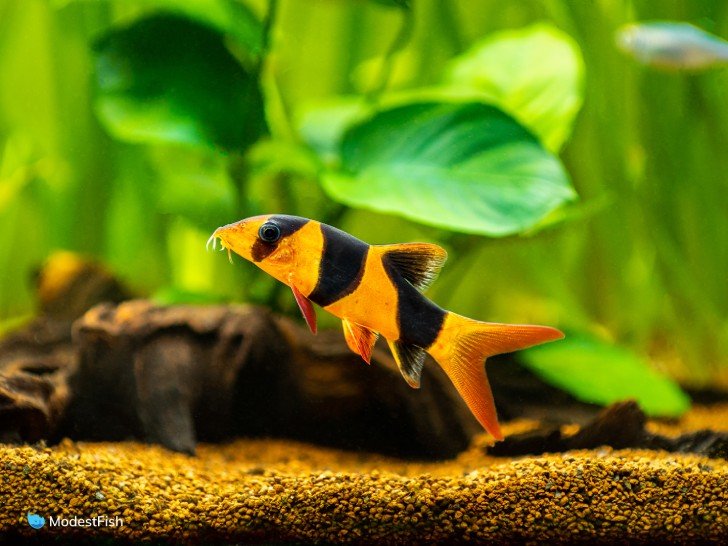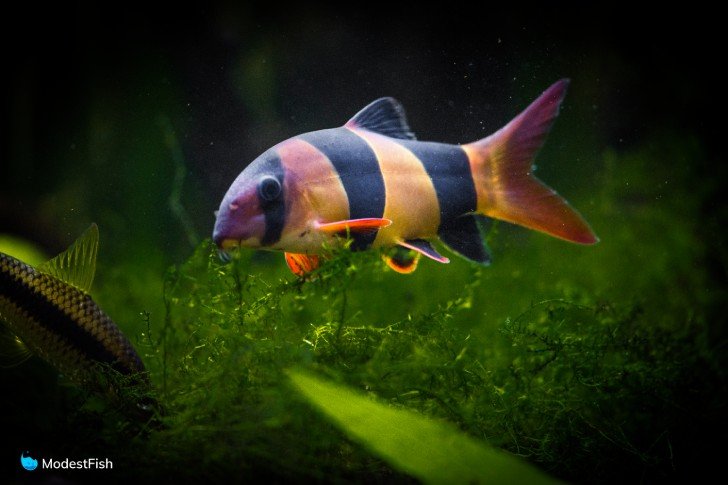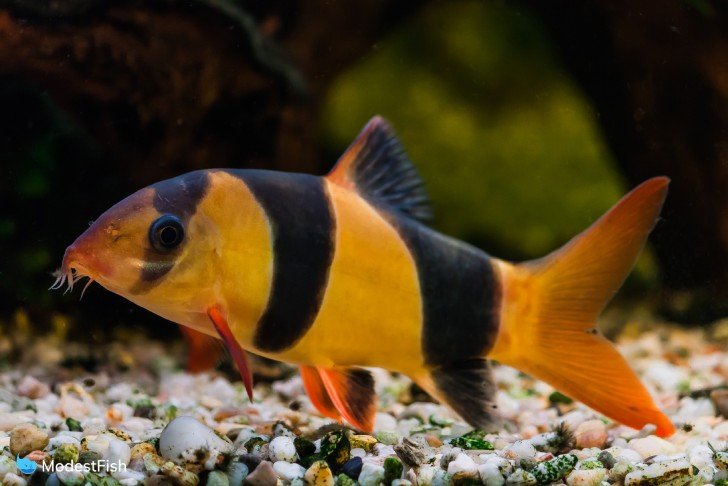I love clown loaches. I think they’re beautiful and a great addition to your aquarium.
But you need to serious commitment to care for them properly.
Here’s what you should expect.
Clown Loach Quick Stats:
- Min. Tank size: 100 gallons (379 liters)
- Temperature: 78°-85°F (26°-29°C)
- Care level: medium – hard
- Diet: carnivore
- Behavior: peaceful, schooling bottom feeder
- How many can be kept together: you need to keep at least five, but more is always preferable if you have the room
- Size: 12 inches (30 centimeters)
Scientific Classification
- Kingdom: Animalia
- Phylum: Chordata
- Class: Actinopterygii
- Order: Cypriniformes
- Family: Botiidae
- Genus: Chromobotia
- Species: C. macracanthus
Tank Size (Important)

Before I even talk about what this species looks like, or what it’s like in the wild, I just want to get this out there.
The most important information for me to tell you about clown loaches (Chromobotia macracanthus) is that you need a BIG tank for this species.
I’m talking a 100 gallon (379 liters) tank at an absolute MINIMUM!!!
I really want to drive this home right off the bat so anyone thinking about owning this species understands that these fish get very large and must be kept in big groups to truly be happy.
The cute little clown loach that you see at the live fish store is going to grow into a 12 inch (30 centimeter) tank buster.
And if you’re doing it right, that means you’ve got an entire school of tank busters!
Since this species must be kept in a group of at least five or more, that equates to a huge bioload from just this one species.
Seriously, don’t buy these fish unless you have a big enough tank.
I’m sorry to start out with something that can be a bit of a downer, but I would much rather that someone pass this species by than for fish to end up in a tank that is much too small for them.
Pro Tip: If you’re looking for similar fish that don’t grow as large, take a look at the zebra loach (Botia striata). They’re a gorgeous little fish that only gets to be about 4 inches (10 centimeters) or so, much more suitable for the average aquarist.
Appearance

Clown loaches exhibit a body shape common among catfish species, they have a long, somewhat plump body with a flattened ventral side (belly) that makes it easier for them to swim along the bottom.
They have very pointy snouts that sport several pairs of barbels, fleshy whisker-like appendages around their mouths. Barbels are sense organs for both touch and taste that help the loaches to locate food as they search around rocks and plants in their native waterways.
Their heads taper strongly from their snouts to a domed skull. Their bodies slope gently along their backs until it reaches their tail.
Clown loaches have distinctive coloring. When they’re juveniles and young adults, they are a dusky sunset orange color, with three wide black bands that wrap around their bodies.
This “tiger stripe” coloration is one of the things that draw people to this species.
But, you should also know, that once they become sexually mature adults, the bright orange will become a much more muted coppery color and the black bands will turn more of a grayish to dark brown color.
So, if your only attraction to this species is the color, you should be aware that it won’t stay that way forever.
How to Set Up a Clown Loach Tank

Heater
Clown loaches come from tropical waters, and so, a heater is an absolute must.
They can tolerate temperatures as low as 75°F/24°C but their preference is 78°-85°F (26°-29°C).
Being kept at lower temperatures can stress this fish and make it more susceptible to pathogens like Ich. Warmer is most often better when it comes to these fish.
Filtration & The Nitrogen Cycle
An aquarium filter is arguably the most important piece of equipment. Without it, keeping fish wouldn’t even be possible.
Fish constantly put out waste in the forms of urine and feces.
All that poop and pee sinks to the bottom of the tank and collects in the substrate, where it starts to decompose.
The waste starts to put off ammonia (NH3) as it breaks down. That’s a really bad thing because ammonia is highly toxic to fish and other aquatic animals.
Left to itself, the tank would become unlivable. The fish would keep putting off waste, which would cause more and more ammonia to be created. It would build in the tank until the water became completely toxic and killed off all the fish.
Luckily, aquarium filters create an environment that keeps this from happening.
There are several species of beneficial bacteria that live in our filters and eat toxic substances, like ammonia, and turn them into less toxic substances. This process is known as the aquarium nitrogen cycle.
One kind of bacteria eats ammonia and turns it into a compound called nitrite (NO2 -1). Nitrite is also highly toxic, fortunately it gets eaten up almost immediately by another kind of bacteria that converts it to something called nitrate (NO3-).
Nitrate is much less harmful than ammonia or nitrite so it can be allowed to build up in the water between aquarium cleanings.
Pro Tip: For more detailed information about the nitrogen cycle, please look here.
Filters hold something called biomedia; basically, it’s porous material put in the filter that water can flow through. Beneficial bacteria grows throughout the biomedia and eats waste products out of the water as it moves through the filter.
Keeping a school of fish that get so big means you’ve got to have some serious filtration power.
Clown loaches are very active fish with a voracious appetite. They’re going to produce a ton of waste so you need a filter with enough biomedia capacity to process all that poop.
It’s important to make sure your filter can keep up with the waste produced by your fish. I’d really recommend going with a canister filter for a tank over 100 gallons so that you can maximize the filtration capacity for your tank.
Substrate
Clown loaches prefer a soft, sandy bottom for them to dig through.
If you do choose to keep them on gravel, make sure that it’s a smooth gravel to hopefully avoid sharp edges that can wear down a loaches barbels.
Lighting
Clown loaches prefer dim lighting. They may only come out after the lights are turned off if the tank is too bright.
You might need to use a dimmer to bring light levels down and make the loaches more comfortable.
Pro Tip: Check with your light’s manufacturer to see if it is compatible with a dimmer.
Plants and Decor
I think it’s important to mention that adult clown loaches are notorious for destroying live plants. They’ll dig up their roots and poke holes in the leaves.
So, if your dream is a huge, beautifully planted aquarium, you don’t want this species.
As far as decor, it’s extremely important to provide these fish with a wide variety of hiding places. They need spaces under driftwood, large caves, rock work, etc so they can retreat for part of the day. They also like to hide together, piled up in a mass to a comical degree, so they need hiding spaces big enough for several fish.
Clown loaches get extremely stressed and will decline in health if they do not have suitable areas to hide in when they feel vulnerable.
I would recommend splitting the floor space with one half being covered with heavily hardscaped areas with lots of rocks, decor and driftwood and the other being totally open swimming areas.
That would give the loaches lots of hiding places but also leave some open space to cruise through as a school.
Diet
In the wild, clown loaches mostly eat meaty foods, like snails and other invertebrates.
In the aquarium, they are also known to enjoy veggies like blanched zucchini.
Just like with all fish, it’s good to offer this species a varied diet to make sure they get all the nutrients they need.
When I’ve kept them in the past, I always made a high quality sinking wafer, like Omega One Veggie Rounds or Omega One Shrimp Pellets, their staple food.
| Preview | Product | |
|---|---|---|

|
Omega One Sinking Shrimp Pellets, 8mm Pellets, 8.25 oz | Buy on Amazon |

|
Omega One Veggie Rounds, 14mm Rounds, Sinking, 8 Oz Container | Buy on Amazon |
Last update on 2024-04-25 / Commissions Earned / Images from Amazon Product Advertising API
They’re also fond of eating flake food that sinks down to the bottom, so I would let them have a little of that.
And then bloodworms, California blackworms and freeze dried tubifex worms make excellent treats, along with pieces of blanched veggies like zucchini, carrot or sweet potato.
Breeding Clown Loaches
This species does not breed readily in an aquarium setting.
Commercial breeding operations in Asia breed them by adding hormones to the water column to trigger the fish to spawn.
Sorry, but it’s pretty much impossible that you will hit it big by breeding clown loaches as a side hustle.
Clown Loach Tank Mates
Clown loaches are very peaceful and mostly just ignore other species of fish in the tank.
They’re also savvy and good at staying out of the way of bigger, more aggressive fish.
I’ve kept them with South American cichlids. I’ve seen them in with African cichlids, community tanks, rainbow fish tanks, all sorts of things.
They get along fine with suckermouth catfish like plecos and oto cats.
Mixing them with other bottom dwellers, like corydoras catfish, could lead to disputes about hiding places and they would compete for food.
Given enough space, you might be able to incorporate another bottom feeder, but you’d need to be careful to make sure smaller fish are able to get their share of food.
However, I do not recommend you mix them with invertebrates. These guys would be more than happy to devour any shrimp or snails they come across.
Snails small enough to fit in their mouths will be crunched up with their grinding teeth. Bigger snails will be pulled out of their shells and picked to death.
Read More: Clown Loach Tank Mates
Is a Clown Loach Right for You?
I love this species, I think they’re beautiful and an all around great fish.
But I really want to warn people away from them unless they already have a big enough tank to house them.
Purchasing, setting up and maintaining a 100 gallon or larger tank is a big commitment, in both time and money, that the average aquarist may not be able to fulfill.
If you’re not prepared to provide this level of space and care, then please go with another species, like zebra loaches, yoyo loaches or Burmese border loaches.
These all have a body shape and behavior that is similar to clown loaches, but they only get 4-5 inches (10-12.5 centimeters) long. They may not have the orange and black coloration, but they are beautiful fish in their own right.
If you do have the room to keep a school of clown loaches, I highly recommend them. They’re total goofballs with funky little personalities.
They truly earn the name clown. They’ll swim around and explore anything new, pile themselves together in tiny spaces and generally just make you laugh every day.
Clown loaches are great cleaner fish. They’re especially great to keep with messy eaters like rainbowfish. They’ll find every last bit of food left behind by your top dwelling fish.
It’s easy to see why this fish is so popular in the aquarium trade and they have a special place in my heart as well.

Thanks for this information. It was very informative. Easy to understand. Learn that I have made every mistake. This definitely will helped me understand my fish.